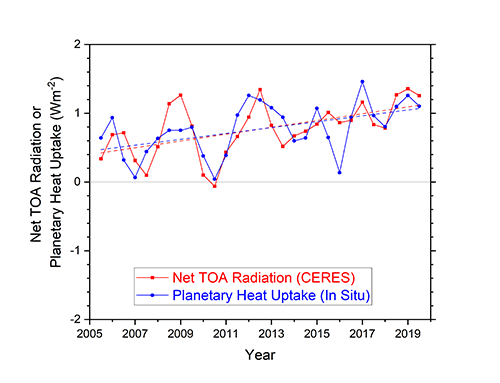Satellite and Argo data reveal doubling of Earth’s heating rate since 2005
Climate is determined by the difference between how much of the sun’s energy the Earth absorbs and how much energy Earth sheds to space through emission of thermal infrared radiation. A stable climate requires a balance between these quantities. Continued increases in concentrations of well-mixed greenhouse gases in the atmosphere has led to a net gain of energy by Earth. Most of this excess energy (about 90%) warms the ocean, with the remainder heating the land, melting snow and ice, and warming the atmosphere. This Earth energy imbalance (EEI) is responsible for the unprecedented changes in surface temperature, sea level, precipitation patterns, and extreme weather that have been observed in recent decades.

Comparison of overlapping one-year estimates at 6-month intervals of net top-of-the-atmosphere annual energy flux from the CERES EBAF Ed4.1 product (solid red line) and an in situ observational estimate of uptake of energy by Earth climate system (solid blue line). Dashed lines correspond to least squares linear regression fits to the data.
A new study by Loeb and co-authors in Geophysical Research Letters reveals that both satellite observations and in situ planetary heat uptake measurements independently show an approximate doubling of EEI from mid-2005 to mid-2019. The satellite data consist of global measurements of Earth’s radiation budget from the Cloud and the Earth’s Radiant Energy System (CERES). In situ data include ocean heat uptake over 0–2,000 m from the Argo array of profiling floats combined with published estimates of energy uptake by the deeper ocean, lithosphere, cryosphere, and atmosphere. The linear trend through the data implies an EEI of 0.42±0.48 W m-2 in mid-2005 and 1.12±0.48 W m-2 in mid-2019 (uncertainties in the trends correspond to 5-95% confidence intervals). The latter value is equivalent to an annual net gain of energy that is more than 30 times the global primary energy consumption during 2019. The authors further show that marked decreases in clouds and sea-ice and increases in trace gases and water vapor combine to increase the rate of planetary heat uptake. Anthropogenic forcing, internal variability, and climate feedbacks all contribute to the positive trend in EEI while changes in incoming solar radiation have a negligible effect.
The excellent agreement between satellite and in situ trends in EEI demonstrates the tremendous benefit of having independent satellite TOA radiation observations and ocean heat content measurements for tracking changes in EEI.
Satellite and Ocean Data Reveal Marked Increase in Earth’s Heating Rate (Geophysical Research Letters)
Topics
- Climate Change
- Ocean Heat
- Satellites
- Observing Systems
